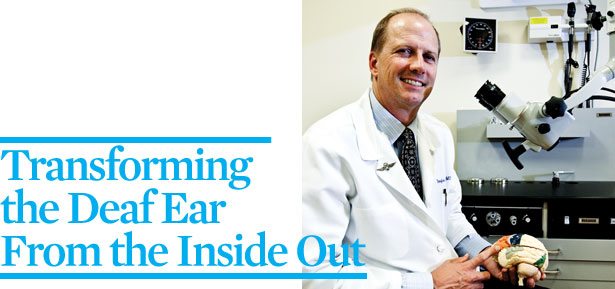
In front of an operating microscope, which he uses to diagnose ear disease in his clinic, Doug Backous indicates the cortex of the brain where motor activity occurs. He routinely operates near those areas.
Photo by Mike Siegel
Doug Backous '84 is director of Seattle's Swedish Center for Hearing and Skull Base Surgery. It is the place, he is convinced, best suited to "change the equation" of a perplexing medical challenge: how to bring people with hearing loss together with the electronic device that can return many of them to the hearing world. That device, a cochlear auditory implant, is inserted beneath the skin near the base of the skull.
"Eighty-five percent of those who could benefit from a cochlear implant never get one," says the microsurgeon and captain of Seattle Pacific University's 1983 national championship soccer team. He believes that because illnesses such as diabetes and heart disease get the most press, the hearing impaired gain little attention or subsidy. "People don't die of hearing loss."
Swedish Hospital can change things because it is "a nonprofit with a conscience," exerts "enormous" regional influence, and enjoys international renown, says Backous. He believes it has the best chances of bringing all the major players together to remove the roadblocks that often limit access to sound for deaf patients who want to hear.
He is spurred on by the case of little Claire. Because the sense of hearing is the key to learning language, the deaf toddler, like many he sees, had no spoken language. "Unless caught early within the first two years of life, the ability to ever generate hearing (and thus, language) is greatly diminished," says Backous. But Claire came in time, was fitted with a cochlear implant at the age of 2, and is today a vivacious high school student, at the top of her class and excited about attending college.
"Eighty-five percent of those who could benefit from a cochlear implant never get one," says Doug Backous. He believes that because illnesses such as diabetes and heart disease get the most press, the hearing impaired gain little attention or subsidy. "People don't die of hearing loss."
"We talk about the cost of an implant," — which is $40,000–50,000 — "but who talks about the savings? The cost to special-educate a deaf child through high school is estimated at $150,000. But if that child receives an implant, she can function at grade level in a mainstream classroom. She can more easily qualify for college and become a productive, tax-paying citizen."
It boils down, the doctor says, to education, accessibility, and economics.
The Backous vision is to integrate the process, to bring audiologists and speech therapists to the table along with insurance companies and implant manufacturers. The patient, he believes, must be at the center of that table.
"We can do it," says Backous, who built an international reputation as a surgeon, educator, and clinician scientist in 12 years at Seattle's Virginia Mason Hospital and Medical Center prior to his work at Swedish. He believes it is his God-given mission to make implants widely available and deliver the best chance at hearing to the great number of people who don't yet know it's even possible.
